Boston Family Album
Reprinted from "Crown Jewels of the Wire", June 2004, page 20
Crown Jewels this month presents insulators manufactured by, or in some way
related to, Boston Bottle Works. Our story extends from page 20 through page 33.
Shown on this page: Upper left: CD 136.4 unembossed; upper right: CD 136.4
unembossed; Lower left: 136.5 embossed Boston Bottle Works; lower right: 143.6
embossed Boston Bottle Works.
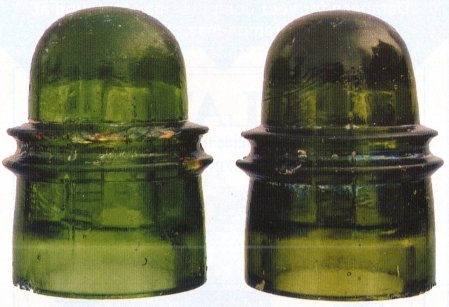
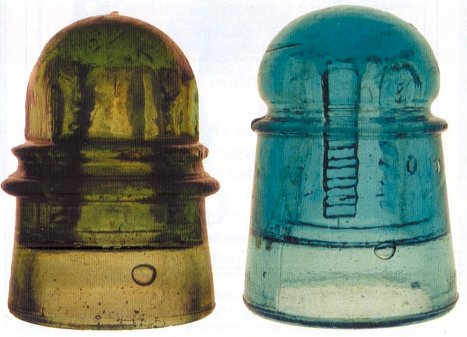
|
The CD 136.7 on the right is embossed: PAT. OCT. 15. 1872. It has three
segmented threads, and is an especially difficult to locate green color.
While similar in appearance to the insulator below, it lacks an inner skirt.
|
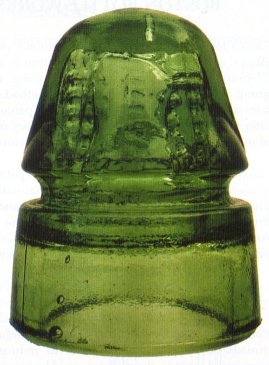
|
|
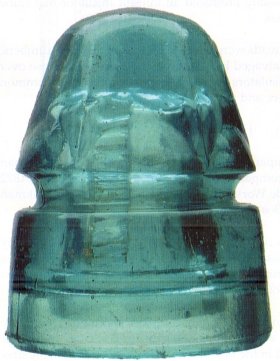
|
A previous owner described the insulator to the left as a CD 136.7 / 158
hybrid.
It has the dome configuration of the 136.7, but the inner skirt of a 158.
The insulator has three segmented threads, and is noticeably shorter than a
158. The dome and wire groove shapes are different than 158's.
Like the insulator above, it is embossed only with the 1872 patent date.
|
(page 21)
BOSTON BOTTLE WORKS INSULATORS
Crown Jewels this month presents insulators manufactured by Boston Bottle
Works, a glass manufacturer in operation in the 1870's when growth in the
telegraph industry was rapidly expanding. Our description of the whole group as
"Bostons" is intended to be a method of describing them. In fact,
certain styles were produced by glass companies that existed both before and
after Boston Bottle. However, the insulators are linked by their peculiar style
of manufacture... the patents of inventor Samuel Oakman.
Oakman was granted almost two dozen patents, not all having do to with
insulators. But collectors are quite familiar with at least two Oakman patents.
The November 13, 1883 patent date found on insulators produced by Brookfield and
other companies refers to the invention of the inner skirt. Another Oakman patent
copied by many companies is the June 17, 1890 patent for a saddle groove,
essential in the development of power insulators.
Less successful, apparently, was Oakman's October 15, 1872 patent for
segmented threads. The patent drawing is shown on the opposite page. In volume 1
of the book, Insulators: a History and Guide to North American Glass Pin type
Insulators by John and Carol McDougald, the idea behind segmented threads is
described as a means to reduce manufacturing costs. With segmented threads, the
plunger could be removed without having to unscrew it from the newly formed
threads. While that may have saved time in the manufacturing process, it
possibly produced an inferior insulator that came unscrewed from the pins
easier.
Insulators with segmented threads were never produced in massive numbers, and
few seem to have been salvaged by telegraph companies for re-use over time. The
result is that the insulators are scarce, with even the most common examples
valued at $500 apiece and up.
HISTORY
The Massachusetts Glass Company was formed in 1867 with Samuel Oakman as its
president. In 1870, the company built a factory at a location that by 1872 was
the home of Boston Bottle Works. In the Boston City Directory, Oakman was listed
an an "agent" for Boston Bottle until 1877.
Oakman's threadless designs may have been produced when the company was
operating as Massachusetts Glass. He received a patent in 1870 for a
"slotted pinhole" design promoted as an improvement over threadless
insulators (see color pictures on page 29 and the patent design on page 30).
After Boston Bottle shut down in 1877, a new company sprang up called Bay
State Glass Works. Oakman was listed as an agent for Bay State in 1878 &
1879. The company was listed in the Boston City Directory as a manufacturer of
insulators.
(page 22)
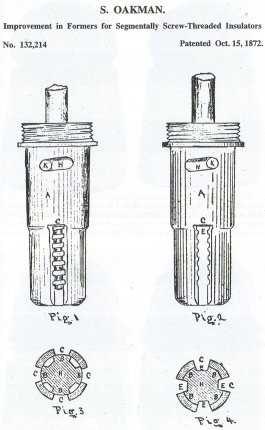
Medium Image
Large Image
(page 23)
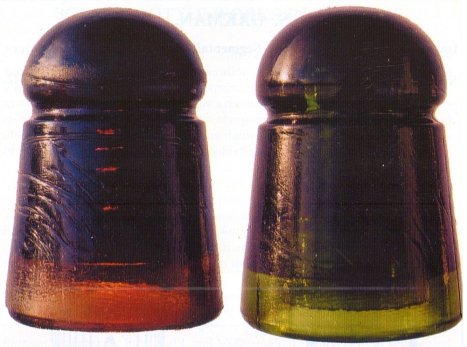
Two of the rarest Boston's are show above: CD 145.6's in outstanding colors.
Both are embossed: BOSTON BOTTLE WORKS PATENT APPLIED FOR. Both have four
segmented threads. Below are two CD 158' s. They are also embossed BOSTON BOTTLE
WORKS PATENT APPLIED FOR; and also have four segmented threads.
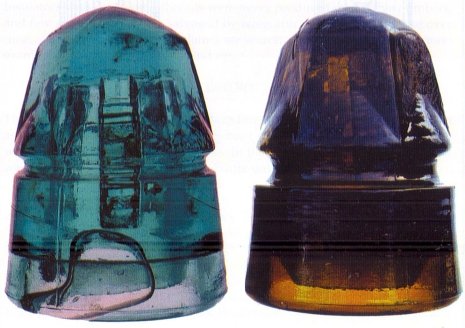
(page 24)
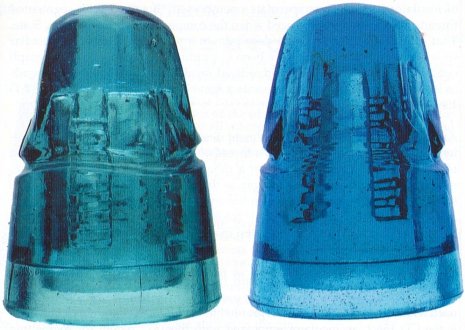
Above are two CD 158.1 insulators embossed CHESTER 104 CENTRE ST. PATENTED.
Produced with four segmented threads, these were quite possibly made by Boston
Bottle for a telegraph supply company located in New York. Below are two CD
158.2 insulators, both embossed BOSTON BOTTLE WORKS PATENT APL'D FOR. They also
have four segmented threads.
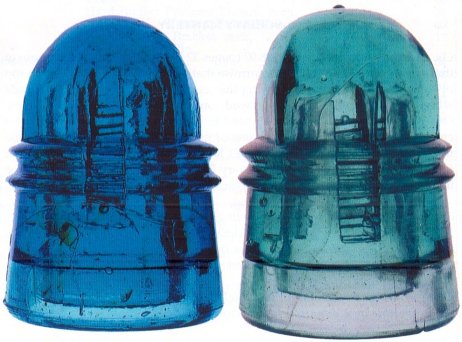
(page 25)
Collectors speculate unembossed "Bostons" with
segmented threads may have been produced when the company was known as Bay
State. That company appears to have closed down in 1879. But Oakman's peculiar
style of insulators may still have been in production. A supplier of telegraph
equipment, Patrick and Cater, advertised insulators with segmented threads in
its 1880 catalog (see ad on opposite page). The style appears to be the CD
136.7.
Among virtues of the segmented thread design described in the ad is the
ability of the insulator to form its own threads. Sounds like the company hoped
to capture a piece of the market at a time when telegraph companies were
upgrading from threadless insulators to threaded. The message seems to be that
if you bought this style of insulator you wouldn't have to buy replacement pins.
Being made of light colored glass is also described as a benefit, as that was
supposed to keep insects from burrowing into the wood pin.
By 1885, Oakman was affiliated with the American Insulator Company in New
York City. American Insulator produced fully threaded insulators that used a new
generation of patents granted to Oakman. Not shown in this issue is the CD
156.2, an insulator embossed with the 1872 patent for segmented threads but
bearing threads like an American Insulator product. Some collectors speculate it
was experimentally made by the New York company before Oakman received his 1884
patent for forming threads the" American" way. Another similar oddball
is the 728.5 American-looking threadless. Crown Jewels hopes to picture these in
a future article about the American Insulator Company.
A SCREWY MYSTERY
Ok, so what's up with the CD 158.9? (pages 32 & 33).What was the purpose
of that screw top? Some collectors surmise that a wrench-like tool fit on the
top of some Boston insulators, allowing the segmented sections to form threads
when the insulators were screwed onto previously threadless pins. Others
speculate the insulator screwed into something, like the bottom of a crossarm.
Some feel there was a glass or metal or wooden cap that fit on the top of the
insulator for some purpose. It is known that a patent was granted to a man named
A.J. Hauty on January 24, 1893 for a self-tying, screw type insulator similar to
the 158.9. However, Boston Bottle Works closed in 1877.
Credits: Photographs by Ray Klingensmith & Carol McDougald. References
include: Insulator Price Guide, by John & Carol McDougald, 2003.
Insulators, A History and Guide to North American Glass Pintype Insulators, by
John & Carol McDougald. Various Pole Top Discoveries auction catalogs,
produced by Ray Klingensmith.
Color printing for this and other articles in this issue of Crown Jewels was
made possible by a donation from Tommy Bolack.
(page 26)
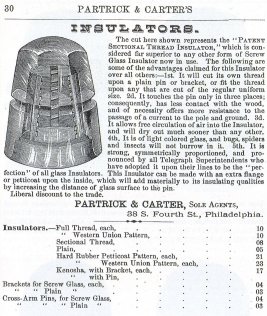
Medium Image
Large Image
WHERE WERE BOSTON'S USED?
Insulators manufactured by Boston Bottle Works and related companies have
been found over a wide area including Pennsylvania, Connecticut, Ohio, New York,
Michigan, Missouri, Georgia and a few other southern states. Broken fragments of
Bostons have been found in a mining district in New Mexico. A bottle collector
dug a broken CD 158.2 in Arizona.
While found at widely scattered locations, the number of insulators uncovered
at anyone site has always been relatively small.
(page 27)
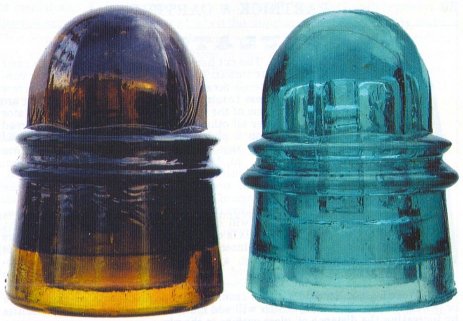
Four more CD 158.2's are shown on this page. But the differences extend
beyond color. The two at the top are embossed: BOSTON BOTTLE WORKS PATENT APLD
FOR. Embossing for the two at the bottom reads, BOSTON BOTTLE WORKS PATENTED
OCT. 15 '72.. All have four segmented threads. This style is nicknamed
"Boston barrels".
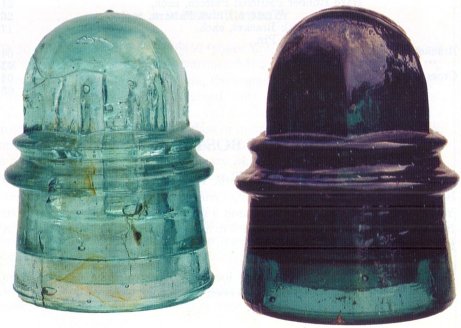
(page 28)
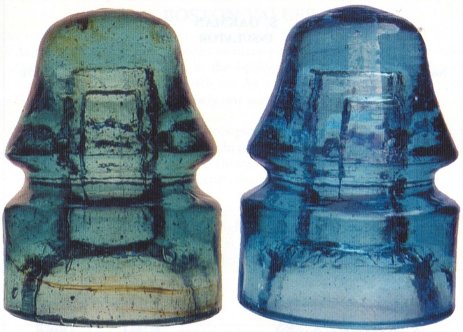
Even threadless insulators with ties to Boston Bottle were manufactured in an
out-of-the-norm manner. The two CD 728.7 above are embossed OAKMAN'S PATENT JULY
26, 1870. They have a slotted pinhole with two slots to more firmly affix the
insulator to the pin. The CD 728.8 on the left below used the same concept and
is embossed: BOSTON BOTTLE WORKS OAKMAN'S PAT JULY 26, 19870. Below, right, is
one of the rarest of all insulators: the CD 796. See page 30 for more
information about this unusual design.
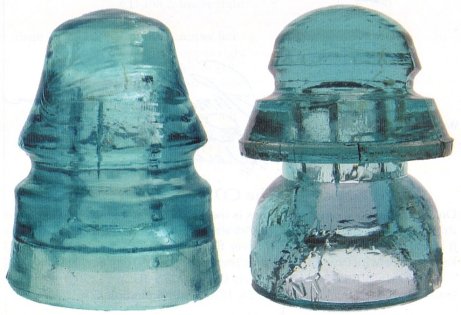
(page 29)
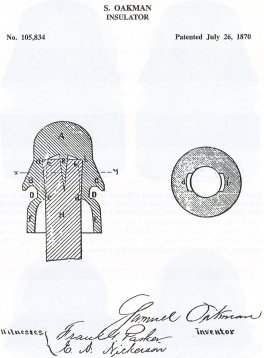
Medium Image
Large Image
The CD 796
One of the hobby's rarest insulators is the CD 796 shown above in the patent
drawing for slotted pinholes. The 796 was not designed as a transposition, as it
might appear. The "umbrella" over the wire groove was just intended to
keep the line wire dry. This insulator is embossed, BOSTON BOTTLE WORKS / NO
SOMERVILLE / MASS (skirt) OAKMAN'S JULY 26 '70 / PATENT (base) OAKMAN'S PATENT
JULY 26, 1870 (around pin hole).
(page 30)
BOSTON VALUES
As a group, Boston Bottle Works insulators are arguably the most valuable
"brand name" of insulators in the hobby. Oakman's segmented thread
concept just didn't seem to catch on. As a result, very limited numbers of
Bostons were made, and extremely few survived of some styles.
The following list is of the insulators pictured in this issue. The value
given is either what the insulator sold for in recent years, or what it's value
is listed at in McDougald's Price Guide. (Many of the Bostons shown in this
issue were also recently sold in the auction described on pages 34 through 37.)
|
Page 20
|
CD 136.4, upper left
|
$4,000*
|
|
|
CD 136.4, upper right
|
$5,225
|
|
|
CD 136.5, lower left
|
$6,050
|
|
|
CD 143.6, lower right
|
$5,000*
|
|
Page 21
|
CD 136.7, top
|
$15,400
|
|
|
CD 136.7 / 158
|
$1,100
|
|
Page 24
|
CD 145.6, upper left
|
$16,500
|
|
|
CD 145.6, upper right
|
$17,600
|
|
|
CD 158, lower left
|
$850
|
|
|
CD 158, lower right
|
$12,650
|
|
Page 25
|
CD 158.1, upper left
|
$ 4,950
|
|
|
CD 158.1, upper right
|
$6,325
|
|
|
CD 158.2, lower left
|
$2,750
|
|
|
CD 158.2, lower right
|
$880
|
|
Page 28
|
CD 158.2, upper left
|
$17,600
|
|
|
CD 158.2, upper right
|
$632
|
|
|
CD 158.2, lower left
|
$1,760
|
|
|
CD 158.2, lower right
|
$3,520
|
|
Page 29
|
CD 728.7, upper left
|
$1,750*
|
|
|
CD 728.7, upper right
|
$1,815
|
|
|
CD 728.8, lower left
|
$3,000
|
|
|
CD 796, lower right
|
$20,000*
|
|
Page 32
|
CD 158.9
|
$5,000
|
|
Page 33
|
CD 158.9 World Record
|
$35,000
|
Editor's note: Values marked with an * are from McDougald's Price Guide.
(page 31)
CD 158.9 MYSTERY
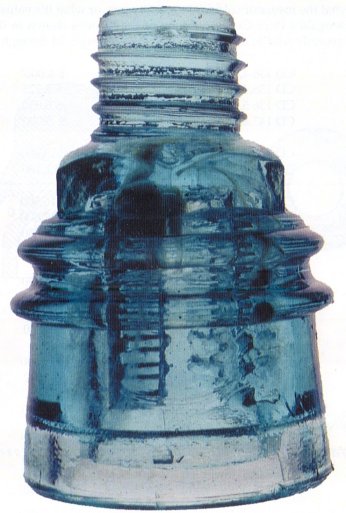
Affectionately called "screwtops", CD 158.9 insulators remain one
of the hobby's most enduring mysteries. What were those screw tops used for?
While there's been lots of speculation, the exact use is still up for debate.
Was there another glass part that screwed on the top? Did the insulator screw
into the underside of a crossarm? Whatever the reason, the unusual shape and
extreme rarity of the CD 158.9 Bostons has made them aristocrats of the hobby.
(page 32)
WORLD'S MOST VALUABLE!
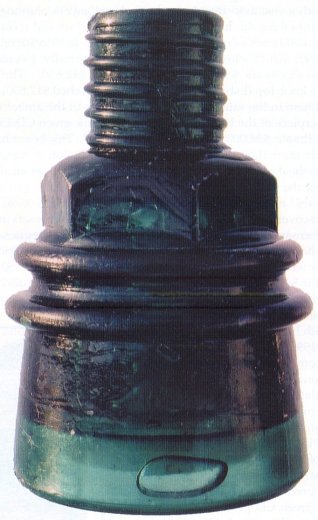
This CD 158.9 "Screwtop" in emerald green presently holds the
distinction of being the hobby's "most valuable insulator". Embossed
BOSTON BOTTLE WORKS PATENT APPLIED FOR, this insulator sold for $35,000 this
spring. Previously the highest price paid for an insulator was for a CD 138.9
Miller "twin pin". The only mint example of a CD 138.9 known brought
over $30,000 when it sold several years ago. Hmmm... An amber CD 158.9 is also
known to exist.. Would it bring even more than the emerald green?
(page 33)
|
